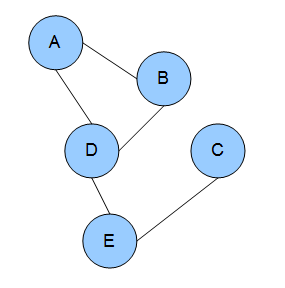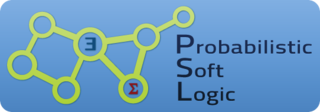A hidden Markov model (HMM) is a Markov model in which the observations are dependent on a latent Markov process. An HMM requires that there be an observable process whose outcomes depend on the outcomes of in a known way. Since cannot be observed directly, the goal is to learn about state of by observing . By definition of being a Markov model, an HMM has an additional requirement that the outcome of at time must be "influenced" exclusively by the outcome of at and that the outcomes of and at must be conditionally independent of at given at time . Estimation of the parameters in an HMM can be performed using maximum likelihood estimation. For linear chain HMMs, the Baum–Welch algorithm can be used to estimate parameters.
In machine learning, the perceptron is an algorithm for supervised learning of binary classifiers. A binary classifier is a function which can decide whether or not an input, represented by a vector of numbers, belongs to some specific class. It is a type of linear classifier, i.e. a classification algorithm that makes its predictions based on a linear predictor function combining a set of weights with the feature vector.
A Bayesian network is a probabilistic graphical model that represents a set of variables and their conditional dependencies via a directed acyclic graph (DAG). While it is one of several forms of causal notation, causal networks are special cases of Bayesian networks. Bayesian networks are ideal for taking an event that occurred and predicting the likelihood that any one of several possible known causes was the contributing factor. For example, a Bayesian network could represent the probabilistic relationships between diseases and symptoms. Given symptoms, the network can be used to compute the probabilities of the presence of various diseases.
In theoretical linguistics and computational linguistics, probabilistic context free grammars (PCFGs) extend context-free grammars, similar to how hidden Markov models extend regular grammars. Each production is assigned a probability. The probability of a derivation (parse) is the product of the probabilities of the productions used in that derivation. These probabilities can be viewed as parameters of the model, and for large problems it is convenient to learn these parameters via machine learning. A probabilistic grammar's validity is constrained by context of its training dataset.

In the domain of physics and probability, a Markov random field (MRF), Markov network or undirected graphical model is a set of random variables having a Markov property described by an undirected graph. In other words, a random field is said to be a Markov random field if it satisfies Markov properties. The concept originates from the Sherrington–Kirkpatrick model.
In statistical learning theory, the principle of empirical risk minimization defines a family of learning algorithms based on evaluating performance over a known and fixed dataset. The core idea is based on an application of the law of large numbers; more specifically, we cannot know exactly how well a predictive algorithm will work in practice because we do not know the true distribution of the data, but we can instead estimate and optimize the performance of the algorithm on a known set of training data. The performance over the known set of training data is referred to as the "empirical risk".

Feedforward refers to recognition-inference architecture of neural networks. Artificial neural network architectures are based on inputs multiplied by weights to obtain outputs (inputs-to-output): feedforward. Recurrent neural networks, or neural networks with loops allow information from later processing stages to feed back to earlier stages for sequence processing. However, at every stage of inference a feedforward multiplication remains the core, essential for backpropagation or backpropagation through time. Thus neural networks cannot contain feedback like negative feedback or positive feedback where the outputs feed back to the very same inputs and modify them, because this forms an infinite loop which is not possible to rewind in time to generate an error signal through backpropagation. This issue and nomenclature appear to be a point of confusion between some computer scientists and scientists in other fields studying brain networks.
In deep learning, a multilayer perceptron (MLP) is a name for a modern feedforward neural network consisting of fully connected neurons with nonlinear activation functions, organized in layers, notable for being able to distinguish data that is not linearly separable.
In statistics, a generalized additive model (GAM) is a generalized linear model in which the linear response variable depends linearly on unknown smooth functions of some predictor variables, and interest focuses on inference about these smooth functions.
A Markov logic network (MLN) is a probabilistic logic which applies the ideas of a Markov network to first-order logic, defining probability distributions on possible worlds on any given domain.
Conditional random fields (CRFs) are a class of statistical modeling methods often applied in pattern recognition and machine learning and used for structured prediction. Whereas a classifier predicts a label for a single sample without considering "neighbouring" samples, a CRF can take context into account. To do so, the predictions are modelled as a graphical model, which represents the presence of dependencies between the predictions. The kind of graph used depends on the application. For example, in natural language processing, "linear chain" CRFs are popular, for which each prediction is dependent only on its immediate neighbours. In image processing, the graph typically connects locations to nearby and/or similar locations to enforce that they receive similar predictions.
Discriminative models, also referred to as conditional models, are a class of models frequently used for classification. They are typically used to solve binary classification problems, i.e. assign labels, such as pass/fail, win/lose, alive/dead or healthy/sick, to existing datapoints.
Graphical models have become powerful frameworks for protein structure prediction, protein–protein interaction, and free energy calculations for protein structures. Using a graphical model to represent the protein structure allows the solution of many problems including secondary structure prediction, protein-protein interactions, protein-drug interaction, and free energy calculations.
In statistics, a maximum-entropy Markov model (MEMM), or conditional Markov model (CMM), is a graphical model for sequence labeling that combines features of hidden Markov models (HMMs) and maximum entropy (MaxEnt) models. An MEMM is a discriminative model that extends a standard maximum entropy classifier by assuming that the unknown values to be learnt are connected in a Markov chain rather than being conditionally independent of each other. MEMMs find applications in natural language processing, specifically in part-of-speech tagging and information extraction.
A constrained conditional model (CCM) is a machine learning and inference framework that augments the learning of conditional models with declarative constraints. The constraint can be used as a way to incorporate expressive prior knowledge into the model and bias the assignments made by the learned model to satisfy these constraints. The framework can be used to support decisions in an expressive output space while maintaining modularity and tractability of training and inference.
In machine learning, the kernel perceptron is a variant of the popular perceptron learning algorithm that can learn kernel machines, i.e. non-linear classifiers that employ a kernel function to compute the similarity of unseen samples to training samples. The algorithm was invented in 1964, making it the first kernel classification learner.

Probabilistic Soft Logic (PSL) is a statistical relational learning (SRL) framework for modeling probabilistic and relational domains. It is applicable to a variety of machine learning problems, such as collective classification, entity resolution, link prediction, and ontology alignment. PSL combines two tools: first-order logic, with its ability to succinctly represent complex phenomena, and probabilistic graphical models, which capture the uncertainty and incompleteness inherent in real-world knowledge. More specifically, PSL uses "soft" logic as its logical component and Markov random fields as its statistical model. PSL provides sophisticated inference techniques for finding the most likely answer (i.e. the maximum a posteriori (MAP) state). The "softening" of the logical formulas makes inference a polynomial time operation rather than an NP-hard operation.
The following outline is provided as an overview of, and topical guide to, machine learning:
Dependency networks (DNs) are graphical models, similar to Markov networks, wherein each vertex (node) corresponds to a random variable and each edge captures dependencies among variables. Unlike Bayesian networks, DNs may contain cycles. Each node is associated to a conditional probability table, which determines the realization of the random variable given its parents.
In network theory, collective classification is the simultaneous prediction of the labels for multiple objects, where each label is predicted using information about the object's observed features, the observed features and labels of its neighbors, and the unobserved labels of its neighbors. Collective classification problems are defined in terms of networks of random variables, where the network structure determines the relationship between the random variables. Inference is performed on multiple random variables simultaneously, typically by propagating information between nodes in the network to perform approximate inference. Approaches that use collective classification can make use of relational information when performing inference. Examples of collective classification include predicting attributes of individuals in a social network, classifying webpages in the World Wide Web, and inferring the research area of a paper in a scientific publication dataset.














